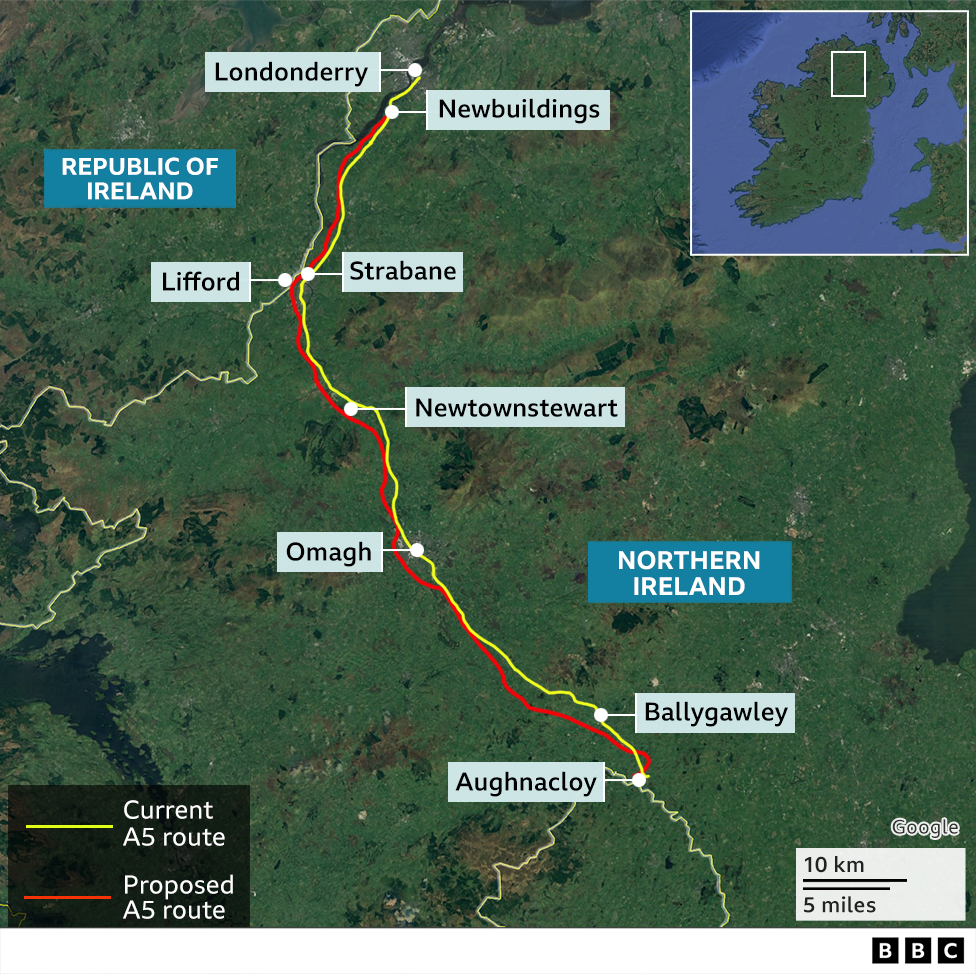What is happening with the long-running saga?
- Published

More than 50 people have been killed on the A5 since 2006
If completed, the A5 dual carriageway would be the largest road scheme in Northern Ireland.
But despite first being announced about 16 years ago, work has not yet started.
A Planning Appeals Public Inquiry has been hearing the arguments for and against the proposals.
What is the A5?
The A5 is a 58-mile (94km) road linking Londonderry with Aughnacloy in County Tyrone, close to the Irish border, and passes the towns of Omagh and Strabane.
It is the main north-south route in the west of Northern Ireland and connects with the A4 road, linking to Belfast via the M1.
The road is also considered a major route for the west of the island of Ireland, providing a link between County Donegal and Dublin, via the N2 dual carriageway south of the border in County Monaghan.

The A5 is single carriageway for most of its length, with some sections of 2+1 overtaking lanes.
According to 2018 data from Stormont's Department for Infrastructure (DfI), the A5 between Omagh and Ballygawley had a daily average traffic of 17,210 vehicles.
Why is it considered so dangerous?
More than 50 people have been killed on the road since 2006.
In one year alone, between October 2021 and October 2022, 10 people died along the A5, according to official figures.
That compares with 15 fatalities in the five-year period between 2015 and 2019.
In the outline business case for the proposed dual carriageway, the department said the increase "points to a rising accident trend".
The most recent fatalities were in April when three people died in a crash near Aughnacloy.

Christine McKane, Dan McKane and Julia McSorley were the latest people to die on the A5
Julia McSorley along with her nephew Dan McKane and niece Christine McKane were killed in that collision. Julia's goddaughter Theresa Finlay said the upgrade needed to happen.
"I don't want to see another fatality, an RTC [road traffic collision] that is 100% avoidable if our roads were made fit for purpose," she said.
The business case also lists several accident blackspots around Ballygawley, Omagh, Sion Mills and Ballymagorry to Strabane.
Campaign group A5: Enough is Enough presented evidence to the inquiry about the dangers of the road.
They are pushing for the dual carriageway project to go ahead.
The group told the hearing that 10.9% of all road deaths in Northern Ireland occurred at locations along the A5, according to DfI figures. The department told BBC News NI these figures are accurate and "disproportionately high" compared to other roads.
Wesley Johnston, a researcher with expertise on Northern Ireland's roads, told BBC News NI that the road has remained "largely unchanged" since the 1960s, with the exception of some town bypasses.
"It's entirely single carriageway the whole way," he said.
"And yet, despite that, it serves an enormous number of side accesses; not just side roads but houses, farms and everything. So, you have an enormous number of side junctions, which means that people are constantly slowing down to turn or turning out."
Mr Johnston said this, combined with the increased traffic on the road, could be a reason for the increasing number of fatal crashes.
What are the proposed improvements?
The A5 Western Transport Corridor (A5WTC) proposal would provide 85 kilometres (53 miles) of dual carriageway from south of Derry at New Buildings to the border at Aughnacloy.
The proposed scheme has been split into phases:
Phase 1A would see the construction of an 8.9-mile dual carriageway from Newbuildings to north of Strabane
Phase 1B phase plans consist of 13.3 miles of dual carriageway from south of Omagh to Ballygawley
Phase 2 would stretch from north of Strabane to south of Omagh
Phase 3 would see construction from Ballygawley to the border near Aughnacloy
How much will it cost?
When the scheme was first announced in 2007, the estimated cost was about £800m.
At the time, the Irish government said it would contribute £400m to the total cost, but this offer was withdrawn in 2011 when budget cuts were being made during the recession.
More recently, Taoiseach (Irish PM) Leo Varadkar indicated his government would "engage constructively" with the authorities in Northern Ireland and would be willing to provide a greater contribution towards costs than previously pledged.
The most recent estimate for the project is £1.6bn.
More than £80m had been spent on the scheme by 2021.
Proposals to create the new dual carriage had the support of the five-party executive at Stormont when it was announced in 2007.
Sinn Féin's Conor Murphy, who approved the upgrade when he was regional development minister, said the delay was "hugely frustrating".
"Over this period of time we have had multiple deaths on this road when this road should have been built," Mr Murphy said.

Campaigners in favour of the A5 project held a demonstration outside the Strule Arts Centre in Omagh before a sitting of the public inquiry
Why has the upgrade not gone ahead?
The proposed A5 dual carriageway has faced opposition since it was first announced.
It has been criticised by the campaign group, the Alternative A5 Alliance (AA5A).
Comprised of farmers, landowners and others with an interest in the County Tyrone area, the group was launched in 2009 to oppose the compulsory purchase of land to construct the road.
It has also raised environmental issues around the project.
The group argued that safety improvements can be made to the current road, such as widening sections to allow for safer overtaking.
And it raised a number of planning objections and legal challenges over the years.
Its latest legal challenge in 2018 resulted in the Department for Infrastructure (DfI) quashing plans to proceed.
In a statement, the AA5A said: "The improvement and upgrade of the existing A5 has long been needed and the AA5A has consistently proposed how this might be done to secure road safety or other benefits in a proportionate and effective away.
"Unfortunately, a consequence of the promotion of the off-line dual carriageway scheme from 2007 onwards has been that the plans that were in hand to upgrade the existing A5 were shelved, so that there has been little upgrade or improvement to the road since then."
However, DfI officials told the inquiry that improvements to the existing road would only partially improve its safety record.
"We would still have a high risk of accidents, would still have a large volume of traffic. All these issues would still exist," Peter Edwards, a technical adviser to the A5 Western Transport Corridor project, told the inquiry.

The public inquiry heard evidence at the Strule Arts Centre in Omagh
What's next?
The inquiry concluded its two weeks of public hearings on Friday.
Commissioner Gareth Kerr told the final day of the inquiry in Omagh, County Tyrone, that he faced "an enormous task".
He said he expects to report back with his recommendations by the end of 2023.
The inquiry heard that if the project is given the go ahead, the DfI is "very confident" the upgrade to the A5 would be completed by 2028.
The business case for the new road has now been approved by the Department of Finance (DoF).
Despite budget constraints, a DfI official told the inquiry he did not foresee any difficulties funding the project.
- Published2 June 2023

- Published31 May 2023

- Published15 May 2023
